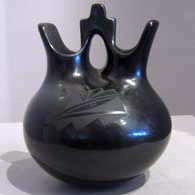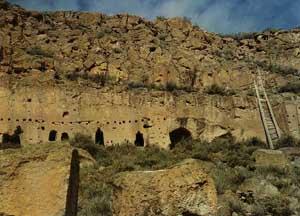
Linda Askan
Santa Clara

Linda Askan was born into the Summer Clan at Santa Clara Pueblo as the daughter of Marie and Andy Askan (Dineh). Her Tewa name, given by Adelaide Sisneros (her grandmother) is Jo Povi, meaning "Cactus Flower." Linda attended the Institute of American Indian Arts but worked as a Respiratory Therapy Technician before deciding to become a full-time potter.
As a child she played with broken pieces of clay that were given to her by her mother and grandmother. Then she started polishing the broken pieces with a stone. Putting her hands in the clay and creating something was natural after that. "We would fire together at my grandparents' corral," she remembers. The traditional method requires firing outside over an open fire, using cottonwood, piñon pine and dry horse manure for fuel. She says, "We experience firing visually: paying attention to the fire, making sure it's evenly burning, being aware the whole time."
As generations of Pueblo potters have done before her, Linda digs her clay in the hills, coils the shapes by hand (pinches the miniatures), and creates black-on-black and red polychrome pots, plates, wedding vases, figures and animals. Her work is elegantly carved and painted in detail. She likes to create pieces that show her reverence for life and reflect her sense of whimsy. Thankfully, the clay that chooses to work with her cooperates in that.
Her miniature nativity sets with thumb-size figures have become collector's items. Evolving over time, her sets often reference sources in Dineh culture with details in the blankets her figures wear. The wise men are modeled after buffalo, deer or eagle dancers, each wearing the respective traditional headgear and robe or blanket. She says she began making her figures this way after participating in the Santa Clara Pueblo Buffalo Dance as a dancer. "I felt the dance," she says. "It was very different from watching, more uplifting to your spirit."
"I make my sets in miniature because it's a size that people can afford," she says. She also likes to offer something collectors might find different: a sense of embodied sacredness from the Native American perspective in combination with the familiar story of innocence and light that is evoked by the nativity scene. She tells us her nativities are designed to carry a powerful and simple message: "Our sacred relationship with the land, the sky, the animals and the elements, passed down through the generations from grandmother to daughter to granddaughter." Linda has two daughters, Diana and Rose, and she has taught both the traditional art of pottery making.
100 West San Francisco Street, Santa Fe, New Mexico 87501
(505) 986-1234 - www.andreafisherpottery.com - All Rights Reserved

Santa Clara Pueblo

Ruins at Puye Cliffs, Santa Clara Pueblo
Santa Clara Pueblo straddles the Rio Grande about 25 miles north of Santa Fe. Of all the pueblos, Santa Clara has the largest number of potters.
The ancestral roots of the Santa Clara people have been traced to ancient pueblos in the Mesa Verde region in southwestern Colorado. When that area began to get dry between about 1100 and 1300 CE, some of the people migrated eastward, then south into the Chama River Valley where they constructed several pueblos over the years. One was Poshuouinge, built about 3 miles south of what is now Abiquiu on the edge of the Jemez foothills above the Chama River. Eventually reaching two and three stories high, and with up to 700 rooms on the ground floor, Poshuouinge was occupied from about 1375 CE to about 1475. Drought then again forced the people to move, some of them going to the area of Puye (on the eastern slopes of the Pajarito Plateau of the Jemez Mountains) and others downstream to Ohkay Owingeh (San Juan Pueblo, along the Rio Grande). Beginning around 1580 CE, drought forced the residents of the Puye area to relocate closer to the Rio Grande and they founded what we now know as Santa Clara Pueblo on the west bank of the river, with San Juan Pueblo to the north and San Ildefonso Pueblo to the south.
In 1598 the seat of Spanish government was established at Yunque, near San Juan Pueblo. The Spanish proceeded to antagonize the Puebloans so badly that that government was moved to Santa Fe in 1610, for their own safety.
Spanish colonists brought the first missionaries to Santa Clara in 1598. Among the many things they forced on the people, those missionaries forced the construction of the first mission church around 1622. However, like the other pueblos, the Santa Clarans chafed under the weight of Spanish rule. As a result, they were in the forefront of the Pueblo Revolt of 1680. One Santa Clara resident, a mixed black and Tewa man named Domingo Naranjo, was one of the rebellion's ringleaders. However, the pueblo unity that allowed them to chase the Spanish out fell apart shortly after their success, especially after Popé died.
When Don Diego de Vargas came back to the area in 1694, he found most of the Santa Clarans on top of nearby Black Mesa (with the people of San Ildefonso). A six-month siege didn't subdue them so finally, the two sides negotiated a treaty and the people returned to their pueblos. However, successive invasions and occupations by northern Europeans took their toll on all the tribes over the next 250 years. Then the swine flu pandemic in 1918 almost wiped them out.
Today, Santa Clara Pueblo is home to as many as 2,600 people and they comprise probably the largest per capita number of artists of any North American tribe (estimates of the number of potters run as high as 1-in-4 residents).
Today's pottery from Santa Clara is typically either black or red. It is usually highly polished and designs might be deeply carved or etched ("sgraffito") into the pot's surface. The water serpent, (avanyu), is a very common traditional design motif on Santa Clara pottery. Another motif comes from the legend that a bear helped the people find water during a drought. The bear paw has appeared on much of their pottery ever since.
Santa Clara has received a lot of distinction because of the evolving artistry the potters have brought to their craft. Not only did this pueblo produce excellent black and redware, several notable innovations helped move pottery from the realm of utilitarian vessels into the domain of art. Different styles of polychrome redware emerged in the 1920s-1930s. In the early 1960s experiments with stone inlay, incising and double firing began. Modern potters have also extended the tradition with unusual shapes, slips and designs, illustrating what one Santa Clara potter said: "At Santa Clara, being non-traditional is the tradition." (This refers strictly to artistic expression; the method of creating pottery remains traditional).
Santa Clara Pueblo is home to a number of famous pottery families: Tafoya, Baca, Gutierrez, Naranjo, Suazo, Chavarria, Garcia, Vigil, and Tapia - to name a few.
100 West San Francisco Street, Santa Fe, New Mexico 87501
(505) 986-1234 - www.andreafisherpottery.com - All Rights Reserved

Adelaide Silva Sisneros Family Tree
Disclaimer: This "family tree" is a best effort on our part to determine who the potters are in this family and arrange them in a generational order. The general information available is questionable so we have tried to show each of these diagrams to living members of each family to get their input and approval, too. This diagram is subject to change should we get better info.
- Adelaide Silva Sisneros & Felix Sisneros
- Joyce Sisneros
- Marie Sisneros Askan & Andy Askan (Navajo)
- Linda Jo'Povi Askan
- Diana Halsey
- Rose Askan
- Birdell Bourdon (1958-)
- Jeff Askan
- Linda Jo'Povi Askan
- Earlene Youngbird Tafoya & Robert Tafoya
- Merton and Linda Sisneros
Some of the above info is drawn from Pueblo Indian Pottery, 750 Artist Biographies, by Gregory Schaaf, © 2000, Center for Indigenous Arts & Studies
Other info is derived from personal contacts with family members and through interminable searches of the Internet and cross-examination of the data found.
(505) 986-1234 - www.andreafisherpottery.com - All Rights Reserved


